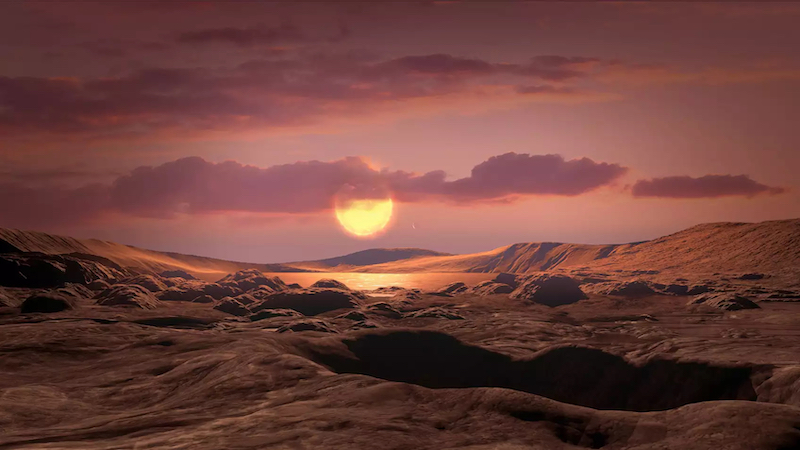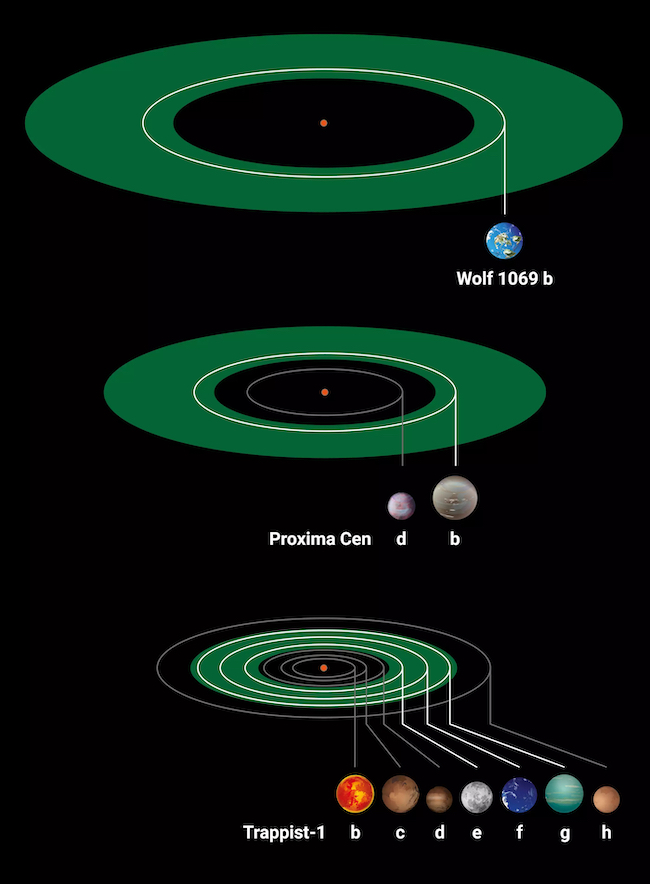
An Earth-size exoplanet next door
Are there nearby planets similar to Earth that support life? We still don’t know, but we’re one step closer to finding out. On February 3, 2023, an international team of researchers announced their discovery of a neighboring Earth-size and Earth-mass exoplanet orbiting in the habitable zone of its star. It’s only 31 light-years away, right next door in galactic terms.
The planet, Wolf 1069 b, orbits a red dwarf star, and scientists think it’s tidally locked to the star (where the same side always faces the star). However, the researchers say it is potentially habitable, particularly on its dayside facing the star. They also say that, unlike many planets orbiting red dwarfs, it may have retained much of its atmosphere. This is due to the fact that the star is less active than many red dwarfs, with less intense radiation or stellar flares.
The planet is similar to Earth in both size and mass. It has a mass of 1.26 +/- 0.21 Earth mass, and its estimated radius is 1.08 Earth radii.
The peer-reviewed journal Astronomy & Astrophysics has accepted the new research paper for publication. A preprint version is available as a PDF or on arXiv.
Last chance to get a moon phase calendar! Only a few left. On sale!
Wolf 1069 b: Earth-size exoplanet may be habitable
Diana Kossakowski at the Max Planck Institute for Astronomy (MPIA) led the team of astronomers who discovered the new planet. The astronomers found the planet while analyzing data for the CARMENES (Calar Alto high-Resolution search for M dwarfs with Exoearths with Near-infrared and optical Echelle Spectrographs) program. The Calar Alto Observatory in Spain collected the data. As Kossakowski stated:
When we analyzed the data of the star Wolf 1069, we discovered a clear, low-amplitude signal of what appears to be a planet of roughly Earth mass. It orbits the star within 15.6 days at a distance equivalent to 1/15 of the separation between the Earth and the sun.
Wolf 1069 b only receives about 65% of the energy from its star that the Earth does from the sun. That may seem odd since it orbits so close to its star. Its star, Wolf 1069, is cooler and emits less radiation than the sun, however. This means that the habitable zone – where temperatures on a rocky planet could allow liquid water – is closer to the star than the habitable zone around our own sun. Kossakowski said:
As a result, the so-called habitable zone shifts inward. Therefore, planets around red dwarf stars such as Wolf 1069 can be habitable even though they are much closer than the Earth is to the sun.
CARMENES is capable of detecting such planets. Co-author Jonas Kemmer from Heidelberg University added:
The CARMENES instrument was built for the very purpose of making it easier to discover as many potentially habitable worlds as possible.

Is Wolf 1069 b really habitable?
So, Wolf 1069 b is similar to Earth in size and mass and resides in its star’s habitable zone. So just how habitable is it? We don’t know for sure, but there are clues. Astronomers say it is likely to be tidally locked, meaning the same side always faces its star. This is just like how the moon always has the same side facing Earth. This happens because one rotation of the planet’s axis takes the same amount of time for the planet to complete one revolution around its star.
Therefore, one side of the planet is always in daylight, while the other side is always dark. Thus, habitable conditions are primarily restricted to a confined area on the day side of the planet. But they can still exist.
Astronomers also calculate the average temperature of Wolf 1069 b to be about -9 degrees Fahrenheit (-23 C). That, however, is if the planet is bare with no atmosphere. The researchers say that if it has an Earth-like atmosphere, then the average temperature could be up to 55 F (13 C). In that scenario, water could remain liquid over a large area of the planet’s day side.
That atmosphere should also help protect against the star’s radiation, just as Earth’s atmosphere does. The planet could also have a magnetic field, although probably a bit weaker than Earth’s.
Wolf 1069 does not appear to be as energetic as most red dwarf stars. That’s good for the possibility of life on Wolf 1069 b, since there is less radiation hitting the planet.
The best habitable exoplanet candidates so far
Wolf 1069 b isn’t the only nearby Earth-mass exoplanet that could be habitable. It is the 6th-closest known such planet in the habitable zone of its star. It is 6th after Proxima Centauri b (4.3 light-years), GJ 1061 d (12 light-years), Teegarden’s Star b and c (12.5 light-years) and GJ 1002 b and c (16 light-years).
TRAPPIST-1e is another. It is one of seven known Earth-size planets orbiting TRAPPIST-1, 40 light-years away. Three of those planets, including TRAPPIST-1 e, are in the habitable zone. TRAPPIST-1 e may be the most potentially habitable of all of them. Its density is similar to Earth’s, and scientists consider it the most likely to possibly have water on its surface.
These are some of the best targets for future additional observations in terms of potentially habitable exoplanets. One reason is that their characteristics are intriguing, but also because they are relatively close and therefore easier to study. It may be a few more years, however, before we can detect any biosignatures, if they exist. As Kossakowski noted:
We’ll probably have to wait another 10 years for this. Though it’s crucial we develop our facilities considering most of the closest potentially habitable worlds are detected via the RV method only.
Other habitable exoplanet sources
This NOVA article describes what kind of planets in the habitable zone are the best candidates for life. It includes a diagram of many of the known planets so far (as of May 2022).
In 2020, EarthSky also reported on a list of 24 super habitable worlds. These are planets that could – depending on additional data – be even more habitable than our own Earth.
The Habitable Exoplanets Catalog is also a great resource and currently lists 63 known potentially habitable exoplanets. Twenty-three of those are Earth-sized.
Bottom line: Meet Wolf 1069 b, an Earth-size exoplanet only 31 light-years away that resides in its star’s habitable zone. It’s an ideal target in the search for alien life.











